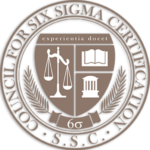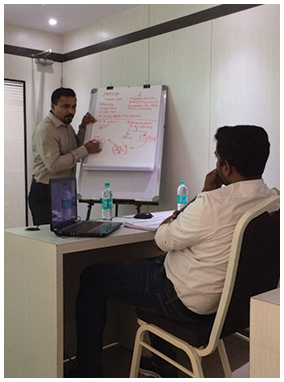8 Days
Defining a Six sigma black belt
An LSS black belt will be driving full time lean six sigma projects and this will be his/her sole responsibility (Ideally)
Black Belts coache and mentor greenbelts , providing critical support from a tools, techniques and methodology point of view, to the green belts
Black belts have to be experts at conceptualizing various frameworks, for resolving business issues across multiple departments ,by engaging different stakeholders from different departments (Cross functional)
Objective of the program
Understand & learn problem solving , process improvement , defect reduction or elimination of variation
Learn a few advanced & in depth techniques to resolve issues around the three basic factors of“ Cost , Time and Quality”, in any business

A comparison between green belt and black belt
Please note that there is no difference in what is taught as “basics of six sigma”, to a GB and BB
Green belts typically work within the function, inside a single department, whereas black belts are mostly involved in cross functional projects
Hence, BBs should have the maturity & ability to coach and mentor green belts and should possess a higher proficiency in training and application of a few advanced statistical tools, as compared to the GBs
Who should attend this program

All certified green belts planning to pursue a full time black belt role

Any professional with process improvements, innovation, continuous service improvement as part of their KRA

Professionals (entry level to mid-level) seriously looking for a job change or seeking a better opportunity. This certification will give your career the required boost, to improve your pay pack .( Data shows that an industry average of 40-50% increase can be expected)

Entrepreneurs who wish to implement lean six sigma in their business to improve customer experience , market share and bottom line

Doctors and healthcare professionals who are into health care and hospital management, focusing on “Customer experience management”

Entry level quality professionals, industrial engineers, process engineers, process consultants from any domain & industry

Management professionals from the hotel & other hospitality industries, responsible for enhancing customer experience and improving bottom line of the company

All business managers who wish to have a defect free /escalation free business process because “you are the first one to know and feel six sigma before your team could work on it.”

Pedagogy followed
DMAIC (Define, Measure, Analyze and Control). To address the 3 basic problem types cost, time and quality in any business and to find sustainable and viable solutions , you just need to know 10 things & that’s precisely what we discuss and teach in an advanced & thorough manner
Why should you attend this program at TrainFirm?
You should attend this program at TrainFirm mainly because of 3 reasons:
- We help to reduce your entry barrier into the six sigma domain by focusing on and teaching what “YOU NEED” to be successful , rather than what we know best
- We do not blindly follow a” one fit for all” approach in our training program Instead, we try to tickle your brain & make you think on matters which are relevant to your line of business
- We work on your basics first and then assist you with step by step instructions on how to progress with a LSS projects until closure (These are “ The basic 10 ingredients ” and 15 basic steps ) with a more advanced and in depth approach in our BB program
What is expected of a certified BB in a company?
You would have to work on 6-7 projects per year
Industry average shows an annual benefit of $ 1000,000/- per BB for the company
Things you should do to be a certified BB
- Complete an 8 full day training with TrainFirm,adding up to a total of 64 hours
- Appear for the exam on the 8th day and pass in the exam with a minimum of 60%( After this you will be receiving a “Trained BB”certificate)
- Discuss with us a project you have completed within 6 months of completion of the training and this will earn you the certificate of a “Certified BB”
Course Contents
- Introduction to Lean Six Sigma
- Project Charter, VOC to CTQs, Kano Model (Practical’s with questionnaire), SIPOC
- Quality function deployment (QFD) with practical’s
- Process Capability, Segmentation & Stratification
- Introduction to statistical distribution (Normal, Exponential, Weibull, T distribution Chi square, F distribution, Poisson, Binomial)
- Introduction to probability and application
- Types of Data
- Run chart, sampling strategy
- Fishbone diagram, data collection plan normality study
- Process capability, segmentation and stratification
- Measurement system analysis (attribute agreement analysis and continuous Gage R&R)
- Box plot, rolled throughput yield, process map analysis
- Pareto, concept of lean, C&I matrix, hypothesis testing
- Correlation, Scatter plot and simple linear regression and multiple linear regression
- Process Management Charts, SPC, Response Plan
- Hypothesis – Formation, Alpha and Beta Risks; Test of Means, Variances, Ratios
- Hypothesis Testing of means, variance and proportions: Parametric and non-parametric hypothesis testing including 1 Sample Z, 1 Sample t test, 2 sample T test, paired t test, 1 proportion test, 2Proportion test, ANOVA (Analysis of Variance), Chi square test, 1 Sample sign, 1 sample Wilcoxon, Man Whitney, Kruskal Wallis, Moods median test.
- Analysis of Multiple Variables: Concept of Rational Sub grouping, ANOVA (Analysis of Variance)
- Case study on Hypothesis testing – Concept of Statistical test flow chart
- Introduction to Lean Concepts – NVA / VA, Poka Yoke, and 5S
- Introduction of VSM
- Criteria based matrix, FMEA, C&B Matrix,
- Screen Potential Causes – Design of Experiments
- Significance of DOE (Design of Experiments) to causation
- DOE Terminology: Main Effects; Interactions; Factors; Settings; Factorial Designs; Degrees of Freedom
- Introduction to Factorial Design- Full and Fractional Factorial
- Factors and Output; DOE requirements; Setting up a DOE study – understanding Alias Table
- Main Effects Plot; Interactions Plot, Pareto with Confidence Intervals, significance of Standardized effect
- Change Management Tools like A-RM-I, GRPI, Stakeholder Analysis, Elevator Speech, Threat and opportunity

